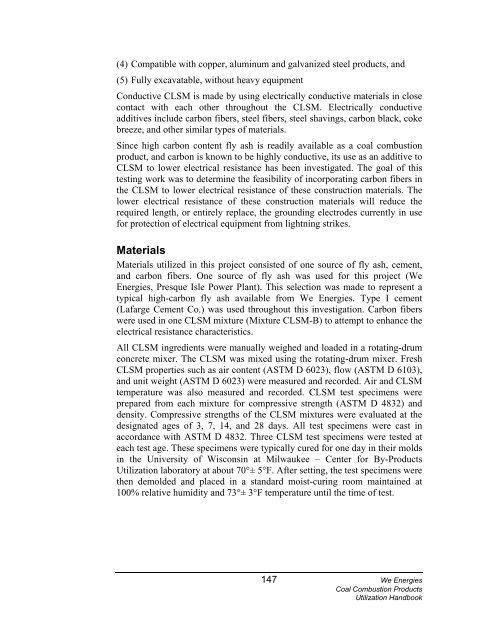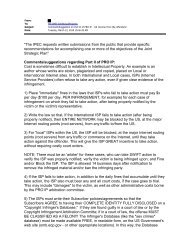We Energies Coal Combustion Products ... - The White House
We Energies Coal Combustion Products ... - The White House
We Energies Coal Combustion Products ... - The White House
Create successful ePaper yourself
Turn your PDF publications into a flip-book with our unique Google optimized e-Paper software.
(4) Compatible with copper, aluminum and galvanized steel products, and<br />
(5) Fully excavatable, without heavy equipment<br />
Conductive CLSM is made by using electrically conductive materials in close<br />
contact with each other throughout the CLSM. Electrically conductive<br />
additives include carbon fibers, steel fibers, steel shavings, carbon black, coke<br />
breeze, and other similar types of materials.<br />
Since high carbon content fly ash is readily available as a coal combustion<br />
product, and carbon is known to be highly conductive, its use as an additive to<br />
CLSM to lower electrical resistance has been investigated. <strong>The</strong> goal of this<br />
testing work was to determine the feasibility of incorporating carbon fibers in<br />
the CLSM to lower electrical resistance of these construction materials. <strong>The</strong><br />
lower electrical resistance of these construction materials will reduce the<br />
required length, or entirely replace, the grounding electrodes currently in use<br />
for protection of electrical equipment from lightning strikes.<br />
Materials<br />
Materials utilized in this project consisted of one source of fly ash, cement,<br />
and carbon fibers. One source of fly ash was used for this project (<strong>We</strong><br />
<strong>Energies</strong>, Presque Isle Power Plant). This selection was made to represent a<br />
typical high-carbon fly ash available from <strong>We</strong> <strong>Energies</strong>. Type I cement<br />
(Lafarge Cement Co.) was used throughout this investigation. Carbon fibers<br />
were used in one CLSM mixture (Mixture CLSM-B) to attempt to enhance the<br />
electrical resistance characteristics.<br />
All CLSM ingredients were manually weighed and loaded in a rotating-drum<br />
concrete mixer. <strong>The</strong> CLSM was mixed using the rotating-drum mixer. Fresh<br />
CLSM properties such as air content (ASTM D 6023), flow (ASTM D 6103),<br />
and unit weight (ASTM D 6023) were measured and recorded. Air and CLSM<br />
temperature was also measured and recorded. CLSM test specimens were<br />
prepared from each mixture for compressive strength (ASTM D 4832) and<br />
density. Compressive strengths of the CLSM mixtures were evaluated at the<br />
designated ages of 3, 7, 14, and 28 days. All test specimens were cast in<br />
accordance with ASTM D 4832. Three CLSM test specimens were tested at<br />
each test age. <strong>The</strong>se specimens were typically cured for one day in their molds<br />
in the University of Wisconsin at Milwaukee – Center for By-<strong>Products</strong><br />
Utilization laboratory at about 70°± 5°F. After setting, the test specimens were<br />
then demolded and placed in a standard moist-curing room maintained at<br />
100% relative humidity and 73°± 3°F temperature until the time of test.<br />
147 <strong>We</strong> <strong>Energies</strong><br />
<strong>Coal</strong> <strong>Combustion</strong> <strong>Products</strong><br />
Utilization Handbook



